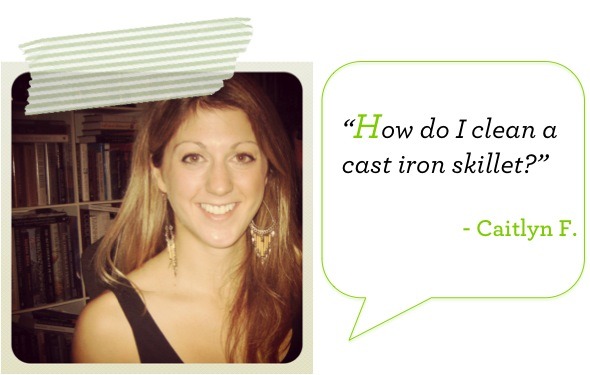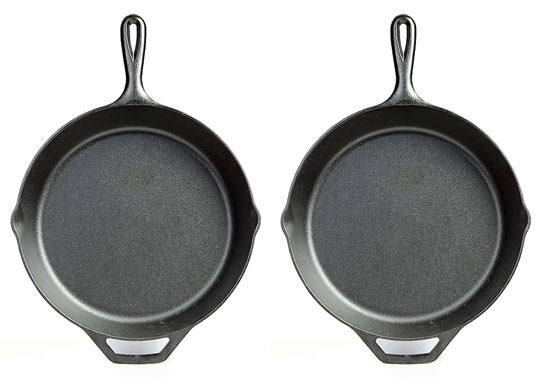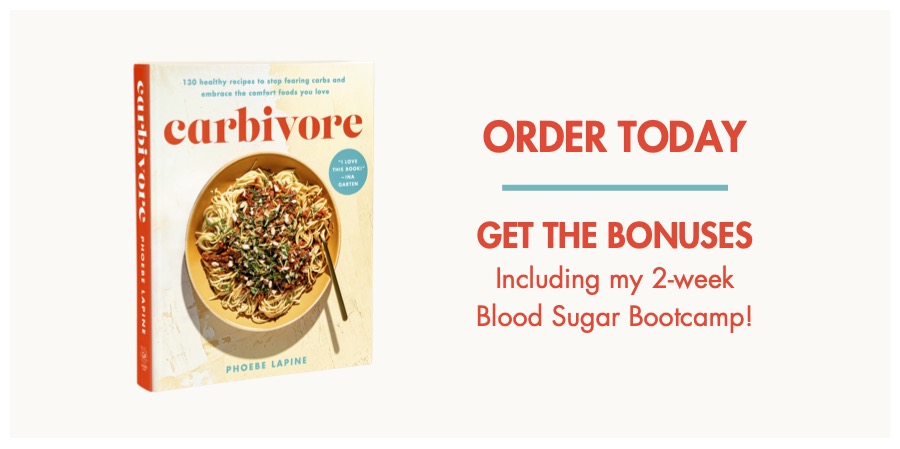
First up…my old roomie, Caitlyn!
Caitlyn F. suffers from a deathly fear of ketchup and mild kitchen OCD. She loves to cook for others, but possibly enjoys cleaning up afterwards more. A native Midwesterner and a health nut, she leans toward cooking healthy(ish) remixes of comfort food. Eating with friends, whether at home or out, is her favorite pastime, especially when sharing is involved.
“I’ve always 

So, for those of you who have not lived with me, here are a few things to wrap your head around when it comes to cast iron skillets. They are the cheapest, best multi-purpose pan around. They also have the potential to out-live you. My mother has had some of hers for 30+ years, and I’m lucky enough to have inherited one of them. If you clean them properly, they are completely non-stick, and a whole lot better for you than cheap teflon pans which scratch easily with metal spatulas and result in harmful pepper-like specks in your food.
Yeah, so you should probably go out and buy a Lodge cast iron skillet.
Most new cast iron skillets come “seasoned,” which means they have been coated in oil and baked at a high temperature until the grease penetrates the iron. To season your own pan, coat it with vegetable oil and bake it at 350° for an hour. Wipe off the oil, and it’s ready to use.
The most important rule of thumb for caring for your skillet is to never use soap. Not ever ever ever. No dishwasher. No sudsy sponge. Just water.
So how do you get the gunk and grime off?
For one, make sure you have a semi-hard bristled brush dedicated entirely to your cast iron skillets. You don’t want anything too rough like a Brillo pad, as that will strip your pan of all the great seasoning it acquires from day to day.
The second trick I learned from Bon Appetit. (If you want more info, visit this article here). After you’ve given the pan an initial rinse under hot water, sprinkle a healthy amount of Kosher salt over the surface (they say to use up to a cup, but I usually get away with a tablespoon or so). Rub the salt around with a folded paper towel. The coarse grains will help brush up any tough bits. Give the pan another rinse. Dry it with either another towel, or by heating the pan up on the stove to burn off any liquid.
Last but not least, drizzle a tablespoon of vegetable oil over the surface and use a paper towel to rub it into the pan. Voila! A very clean, very sanitary cast iron skillet.
If you are still worried about sanitary issues, next time you go to cook with your skillet, simply begin by heating up the pan over a high flame and it will kill any bacteria your crazy OCD mind thinks may have formed.
One final note: you can soak the pan for a little while to soften some of the pesky bits that stick to the pan. But never do it fore more than an hour. While a well-seasoning pan is relatively immune to rust, you don’t want to push it.
Happy cooking!
Xo
Phoebe


I have been in dire need of this information as a new owner of a lodge skillet. Things were getting pretty dicey (and dirty) after I turned my back on the chicken the other day…Thanks, Phoebe!
Haha. Whenever that happens with meat, I always deglaze the pan afterwards (even if what was left in there is too burnt to use as a sauce). You can do this with water or if you do want to make a sauce, some vinegar, lemon juice, or wine. I hope you’re loving the skillet! xo
The accident of fdining this post has brightened my day